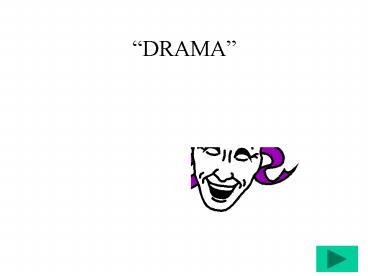DRAMA - PowerPoint PPT Presentation
1 / 11
Title:
DRAMA
Description:
... Manners [makes fun of society and its ways] Analyzing Drama: Setting ... the playwright wants the audience to realize that the cycle of revenge must stop. ... – PowerPoint PPT presentation
Number of Views:274
Avg rating:3.0/5.0
Title: DRAMA
1
DRAMA
- Types of Drama
- Tragedy
- solemn, personal, religious Social Issues
- Tragic Flaw Catharsis
2
Types of Drama
- Tragedy solemn, personal, religious social
issues often ends in death - Tragic Flaw our hero often suffers from great
pride (hubris) and this leads to a grave mistake
leading to tragedy - Catharsis Pity Fear The audience pities the
actors suffering on stage and fears they too
might make a mistake and suffer a similar fate - Comedy humorous/solving often ends in a
marriage - Farce Physical think three stooges
- Satire Morals/ Manners makes fun of society
and its ways
3
Analyzing Drama Setting
- Scenery- (location, time period, social class)
- Lighting-(time, season, mood, action, char-acter)
- Costumes- (age,class,profession,ethnicity)
- Props-(have significance)
- In Agamemnon, remember we are in Ancient Greece
and Ais shown as king and Clytaemnestra is
queen thus they wear fancy robes and have
beautiful masks.
4
Dramatic Structure
Climax
Conflict
Expo
Resolution
- Exposition ( who, what, where, when)
- Introduces our main characters, where and when
they are, and what is happening. - Conflict (Problem of main character)
- In Agamemnon, Agamemnon returns from Troy but
both Clytaemnestra and Aegisthus want revenge on
him. - Climax (Pivotal point in action)
- In Agamemnon, this is where Cassandra tells of
Agamemnons death happening off stage. - Resolution ( How does it all work out?)
- In Agamemnon, at the end, Clytaemnestra and
Aegisthus succeed but the son of Agamemnon,
Orestes, vows revenge on them for his fathers
death. Thus the circle of revenge will continue.
5
Characterization
- Types of Characters
- Protagonist vs. Antagonist
- Confidant (friend or servant)
- Stock characters comic, victim, braggart,
pretender, fool - We learn about characters
- Externally through names, appearance, physique,
speech, accent, dress, status, class, education,
friends, family, interests. - Internally through thoughts, feelings, emotions.
6
Dramatic Irony, Theme and Overall Message
- Dramatic Irony Contrast between what the
characters know and what the audience knows. - In Agamemnon, the audience and chorus knows
Clytaemnestra is up to no good, but Agamemnon
does not. - Theme(s) Repeated ideas or messages throughout
the play. - In Agamemnon, the greatest theme is revenge.
- Overall Message What the playwright wants the
audience to think about the theme(s). - In Agamemnon, the playwright wants the audience
to realize that the cycle of revenge must stop.
7
Greek TheaterShape enhances sound
8
Orchestra
- Literally means dancing space
- Circular and level space made of hard earth,
later periods paved with marble - Chorus would dance, sing, and interact with the
actors who were on the stage near the skene - In the center there was often a thymele or altar
- The orchestra of the theater of Dionysus in
Athens was about 60 feet in diameter
9
Theatron
- literally means "viewing-place" where spectators
sat - usually part of hillside often wrapped around the
orchestra - spectators probably sat on cushions or boards
- by the fourth century the theatron of many Greek
theaters had marble seats - Far enough away hard to see actors faces thus
masks and rich costumes - Actors needed loud voices and move with harmony
10
Skene
- Literally means tent
- Included stage and the building directly behind
the stage - Stage of the theater of Dionysus was probably
raised only two or three steps above the level of
the orchestra approx. 25 ft wide / 10 ft deep - The skene was directly in back of the stage -
usually decorated as a palace, temple, or other
building, depending on the needs of the play no
extravagant sets - Included at least one set of doors, and actors
could make entrances and exits through them - Access to the roof of the skene from behind, so
that actors playing gods and other characters
(such as the Watchman at the beginning of
Aeschylus' Agamemnon) could appear on the roof
11
Parados
- The Parodoi means literally passageways
- Paths the chorus and some actors used for
entrances and exits - The audience also used them to enter and exit the
theater








![[PDF] DOWNLOAD Drama Today: A Critical Guide to British Dram PowerPoint PPT Presentation](https://s3.amazonaws.com/images.powershow.com/10091210.th0.jpg?_=20240802082)






















